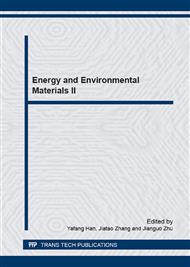p.262
p.268
p.273
p.278
p.286
p.292
p.298
p.303
p.313
Preparation and Characterization of Microporous Activated Carbon from Raw Petroleum Cokes
Abstract:
Adopting the chemical activation method, the high specific surface area activated carbon (AC) was prepared by the solid mixing method using Daqing petroleum cokes as raw materials and KOH as activator. The influence of the ratio of KOH to carbon, activation temperature and activation time on the iodine and methylene blue adsorption properties of the AC were studied. The micro-graphitic structure of the AC was studied by X-ray diffraction (XRD). The BET specific surface area, BJH pore size distribution and pore volume of the AC were determined by N2 adsorption (at 77K). The experimental results show that the high specific surface area AC can be prepared with the ratio of KOH to carbon of 4, activation temperature of 800°C and activation time of 1h. The specific surface area was as high as 2142 m2/g with the iodine adsorption value of 288mg/g and methylene blue adsorption value of 1266mg/g. The XRD and BJH results also show that amorphous carbon was the dominating form, and the pore size distribution represents micropore structure.
Info:
Periodical:
Pages:
286-291
Citation:
Online since:
March 2015
Authors:
Price:
Сopyright:
© 2015 Trans Tech Publications Ltd. All Rights Reserved
Share:
Citation:


